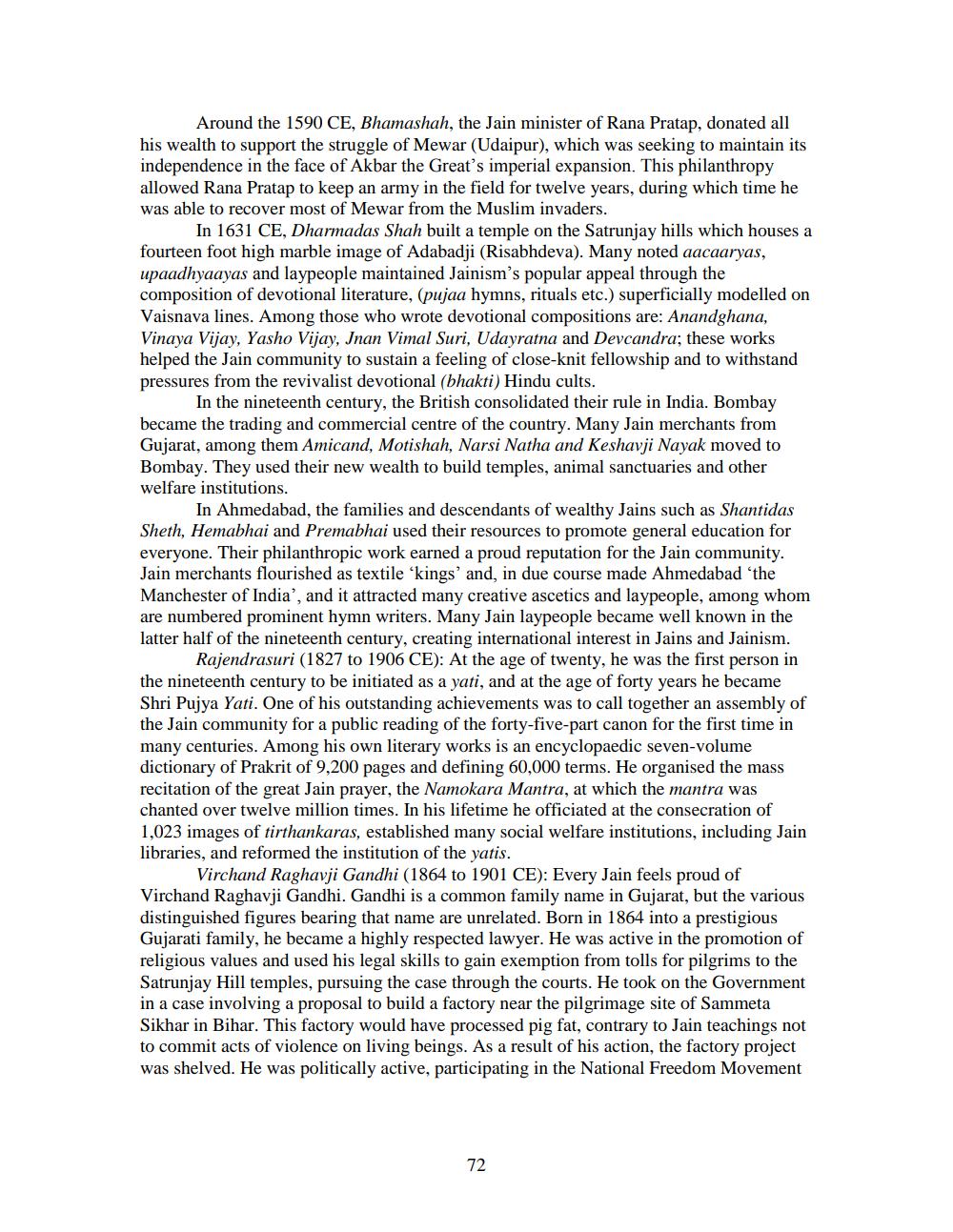________________
Around the 1590 CE, Bhamashah, the Jain minister of Rana Pratap, donated all his wealth to support the struggle of Mewar (Udaipur), which was seeking to maintain its independence in the face of Akbar the Great's imperial expansion. This philanthropy allowed Rana Pratap to keep an army in the field for twelve years, during which time he was able to recover most of Mewar from the Muslim invaders.
In 1631 CE, Dharmadas Shah built a temple on the Satrunjay hills which houses a fourteen foot high marble image of Adabadji (Risabhdeva). Many noted aacaaryas, upaadhyaayas and laypeople maintained Jainism's popular appeal through the composition of devotional literature, (pujaa hymns, rituals etc.) superficially modelled on Vaisnava lines. Among those who wrote devotional compositions are: Anandghana, Vinaya Vijay, Yasho Vijay, Jnan Vimal Suri, Udayratna and Devcandra; these works helped the Jain community to sustain a feeling of close-knit fellowship and to withstand pressures from the revivalist devotional (bhakti) Hindu cults.
In the nineteenth century, the British consolidated their rule in India. Bombay became the trading and commercial centre of the country. Many Jain merchants from Gujarat, among them Amicand, Motishah, Narsi Natha and Keshavji Nayak moved to Bombay. They used their new wealth to build temples, animal sanctuaries and other welfare institutions.
In Ahmedabad, the families and descendants of wealthy Jains such as Shantidas Sheth, Hemabhai and Premabhai used their resources to promote general education for everyone. Their philanthropic work earned a proud reputation for the Jain community. Jain merchants flourished as textile 'kings' and, in due course made Ahmedabad 'the Manchester of India, and it attracted many creative ascetics and laypeople, among whom are numbered prominent hymn writers. Many Jain laypeople became well known in the latter half of the nineteenth century, creating international interest in Jains and Jainism.
Rajendrasuri (1827 to 1906 CE): At the age of twenty, he was the first person in the nineteenth century to be initiated as a yati, and at the age of forty years he became Shri Pujya Yati. One of his outstanding achievements was to call together an assembly of the Jain community for a public reading of the forty-five-part canon for the first time in many centuries. Among his own literary works is an encyclopaedic seven-volume dictionary of Prakrit of 9,200 pages and defining 60,000 terms. He organised the mass recitation of the great Jain prayer, the Namokara Mantra, at which the mantra was chanted over twelve million times. In his lifetime he officiated at the consecration of 1,023 images of tirthankaras, established many social welfare institutions, including Jain libraries, and reformed the institution of the yatis.
Virchand Raghavii Gandhi (1864 to 1901 CE): Every Jain feels proud of Virchand Raghavji Gandhi. Gandhi is a common family name in Gujarat, but the various distinguished figures bearing that name are unrelated. Born in 1864 into a prestigious Gujarati family, he became a highly respected lawyer. He was active in the promotion of religious values and used his legal skills to gain exemption from tolls for pilgrims to the Satrunjay Hill temples, pursuing the case through the courts. He took on the Government in a case involving a proposal to build a factory near the pilgrimage site of Sammeta Sikhar in Bihar. This factory would have processed pig fat, contrary to Jain teachings not to commit acts of violence on living beings. As a result of his action, the factory project was shelved. He was politically active, participating in the National Freedom Movement




